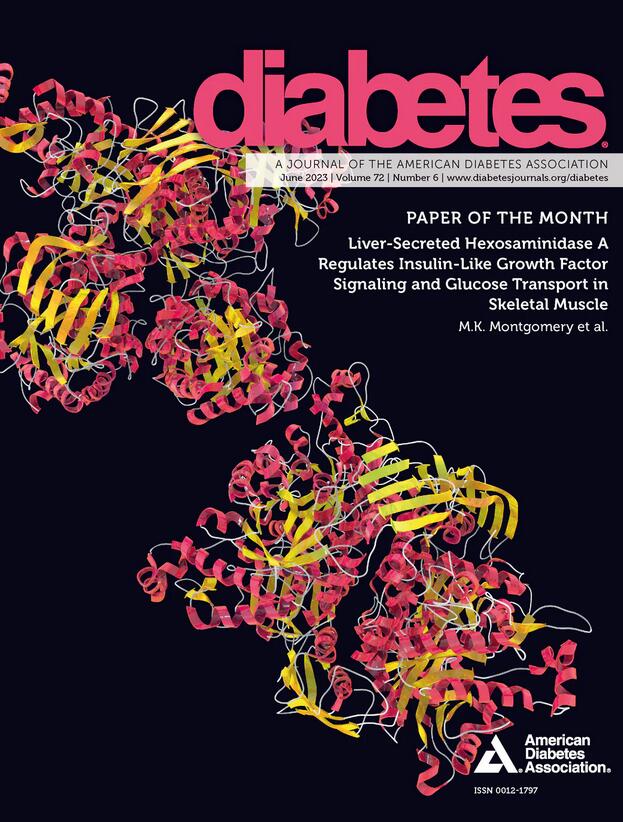1229-P: 血液糖化白蛋白或果糖胺(GA/Fruc)而非血红蛋白 A1c(A1C)有助于鉴别巨型婴儿个体--Meta 分析
IF 6.2
1区 医学
Q1 ENDOCRINOLOGY & METABOLISM
引用次数: 0
摘要
引言& 目的:血糖控制不佳(GC)会增加各种妊娠并发症的风险。A1C 和 GA/Fruc 只需进行一次测量,且无需空腹,因此非常方便。然而,在妊娠期血糖快速变化时,GA/Fruc 可能比 A1C 更能预测并发症。本荟萃分析比较了 A1C 和 GA/Fruc 对妊娠并发症的预测能力。方法:我们全面检索了同时使用 A1C 和 GA/Fruc 预测孕产妇或新生儿不良结局的研究,并检索了每项研究中的最佳临界值,这些研究均提供了 2 x 2 数据(即真阳性、假阴性、真阴性和假阳性病例)。结果:在 9 项符合条件的研究中,7 项研究预测了大畸形,并可使用分层汇总接收者操作特征(HSROC)模型进行元分析。其他并发症因数据数量不足而无法进行分析。与 A1C(0.57 [0.35-0.77])相比,GA/Fruc(0.83 [0.70-0.91])的汇总特异性(95% 置信区间 [CI])明显更高(P=0.02),而 GA/Fruc 的汇总灵敏度(95% CI)为 0.44 (0.26-0.63),A1C 为 0.67 (0.50-0.81)(差异 P 为 0.17)。结论与 A1C 相比,GA/Fruc 可用于确定巨型婴儿的个体。披露 S. Kodama:无。T. Yamada:无。N. Yagyuda: 无:无。K. Fujihara:无。L. Khin:无。M. Kitazawa:无。M. Yamamoto:M. Yamamoto: None.Y. Matsubayashi: None.K. Kato: None.曾根 H:研究资助;诺和诺德、安斯泰来制药公司、Kowa Company, Ltd.、Kyowa Kirin Co.,Ltd.、卫材公司、住友大日本制药株式会社、Novo Nordisk、Astellas Pharma Inc.本文章由计算机程序翻译,如有差异,请以英文原文为准。
1229-P: Blood Glycated Albumin or Fructosamine (GA/Fruc) Rather Than Hemoglobin A1c (A1C) Is Useful for Specifying Individuals Having a Macrosomic Baby—Meta-analysis
Introduction & Objective: Poor glycemic control (GC) increases the risk of various pregnancy complications. Both A1C and GA/Fruc are convenient as they require only one measurement and do not impose fasting. However, GA/Fruc is possibly a better predictor of complications than A1C during pregnancy when GC quickly changes. This meta-analysis compared the predictive ability of pregnancy complications between A1C and GA/Fruc. Methods: We comprehensively searched for studies of prediction of maternal or neonatal adverse outcomes using both A1C and GA/Fruc and for their best cut-off values in each study presenting 2 x 2 data (i.e., true-positive, false-negative, true-negative, and false-positive cases). Results: Of 9 eligible studies, 7 predicted macrosomia and could be meta-analyzed using a hierarchical summary receiver-operating characteristic (HSROC) model. Other complications were impossible to be analyzed because of an insufficient number of data. Pooled specificity (95% confidence interval [CI]) was significantly higher (P=0.02) for GA/Fruc (0.83 [0.70-0.91]) compared with A1C (0.57 [0.35-0.77]) while pooled sensitivity (95% CI) was 0.44 (0.26-0.63) for GA/Fruc and 0.67 (0.50-0.81) for A1C (P for difference, 0.17). Conclusion: Compared with A1C, GA/Fruc is useful for specifying individuals having a macrosomic baby. Disclosure S. Kodama: None. T. Yamada: None. N. Yagyuda: None. K. Fujihara: None. L. Khin: None. M. Kitazawa: None. M. Yamamoto: None. Y. Matsubayashi: None. K. Kato: None. H. Sone: Research Support; Novo Nordisk, Astellas Pharma Inc., Kowa Company, Ltd., Kyowa Kirin Co., Ltd., Eisai Inc., Sumitomo Dainippon Pharma Co., Ltd.
求助全文
通过发布文献求助,成功后即可免费获取论文全文。
去求助
来源期刊

Diabetes
医学-内分泌学与代谢
CiteScore
12.50
自引率
2.60%
发文量
1968
审稿时长
1 months
期刊介绍:
Diabetes is a scientific journal that publishes original research exploring the physiological and pathophysiological aspects of diabetes mellitus. We encourage submissions of manuscripts pertaining to laboratory, animal, or human research, covering a wide range of topics. Our primary focus is on investigative reports investigating various aspects such as the development and progression of diabetes, along with its associated complications. We also welcome studies delving into normal and pathological pancreatic islet function and intermediary metabolism, as well as exploring the mechanisms of drug and hormone action from a pharmacological perspective. Additionally, we encourage submissions that delve into the biochemical and molecular aspects of both normal and abnormal biological processes.
However, it is important to note that we do not publish studies relating to diabetes education or the application of accepted therapeutic and diagnostic approaches to patients with diabetes mellitus. Our aim is to provide a platform for research that contributes to advancing our understanding of the underlying mechanisms and processes of diabetes.
 求助内容:
求助内容: 应助结果提醒方式:
应助结果提醒方式:


